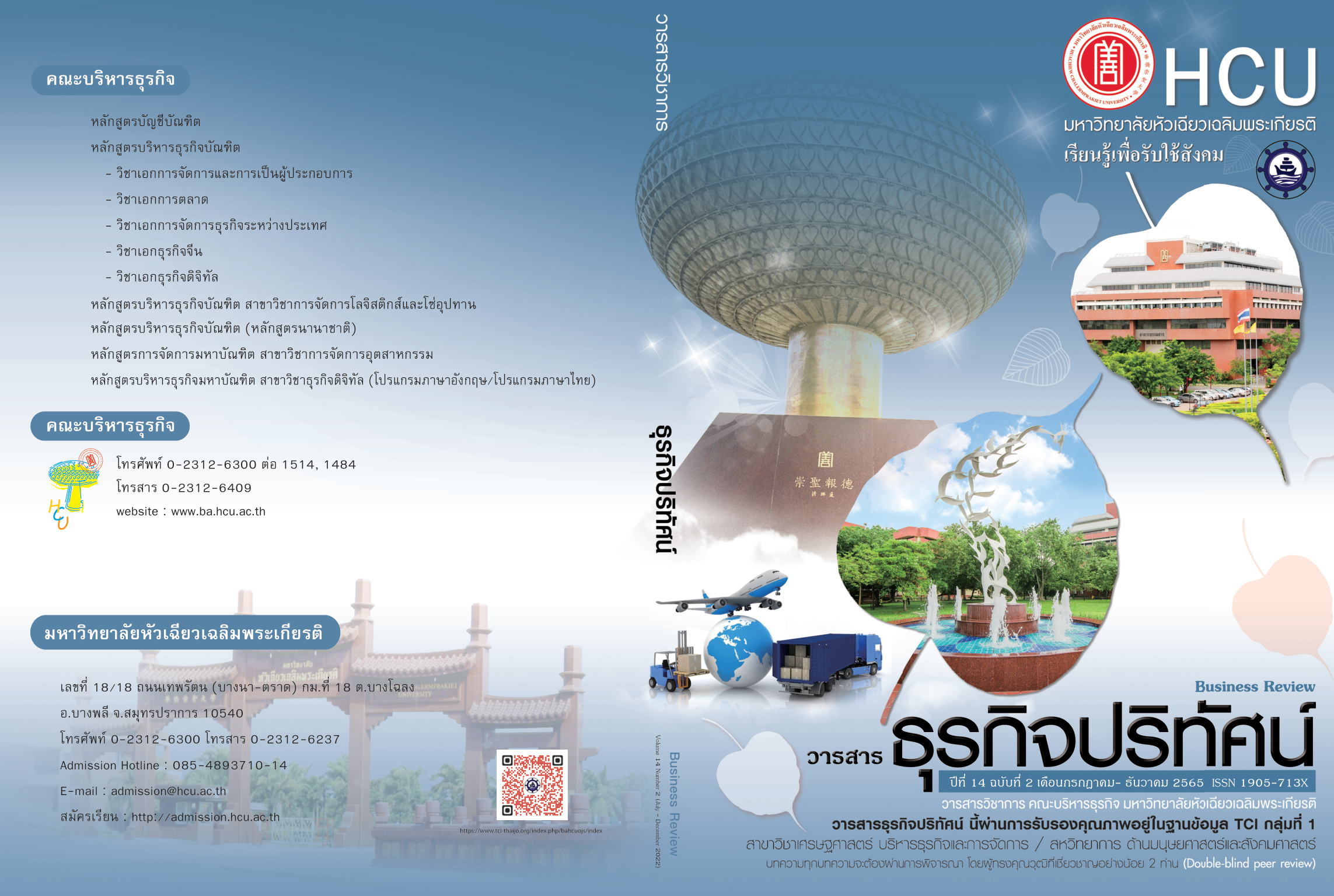Relationship between Communication Style, Perceived Audit Quality, and Clients’ Satisfaction in Non – Listed Companies
Keywords:
Communication Style, Perceived Audit Quality, Clients’ satisfaction, Non- listed CompanyAbstract
The objective of this research is to understand the relationship between (1) communication style, (2) perceived audit quality, and (3) clients’ satisfaction. This research collected data from 423 participants from non-listed companies using a highly structured questionnaire. Data were analyzed using Structural Equation Model (SEM).
The results of this research reveal that affiliation communication style has significantly positive effect on perceived audit quality and clients’ satisfaction. However, dominance communication style does not have any significant effect on perceived audit quality or clients’ satisfaction. Moreover, it was found that perceived audit quality has significantly positive effect on clients’ satisfaction.
References
Beattie, V., and Fearnley, S. (1995). The Importance of Audit Firm Characteristics and the Drivers of Auditor change in UK Listed Companies. Accounting and Business Research, 25(100), 227-239.
Behn et al. (1997). The Determinants of Audit Client Satisfaction among Clients of Big 6 Firms. American Accounting Association Accounting Horizons, 11(1), 7-24.
Black, K. (2008). Business Statistics: for Contemporary Decision Making. New York: John Wiley and Sons.
Browne, M. W., and Cudeck, R. (1993). Testing Structural Equation Models. Newbury Park: Sage.
Byrne, B. M. (2001). Structural Equation Modelling with AMOS. Basic Concept, Application and Programming. London: Lawrence Erlbaum.
Carcello, J. V., Hermanson, R. H., and McGrath, N. T. (1992). Audit quality attributes: The perceptions of partners, preparers, and financial statement users. A Journal of Practice and Theory, 11(1), 1-15.
DeAngelo, L. E. (1981). Auditor size and audit quality. Journal of Accounting and Economics, 3,183-199.
Duff, A. (2004). AUDITQUAL: Dimensions of Audit Quality. Edinburgh: Institute of Chartered Accountants of Scotland.
Duff, A. (2009). Measuring audit quality in an era of change an empirical investigation of UK audit market stakeholders in 20025 and 2005. Managerial Auditing Journal, 24(5), 400-422.
Fornell, C., and Larcker, D. F. (1981). Evaluating Structural Equation Models with Unobservable Variables and Measurement Error, Journal of Marketing Research, 18(1), 35-90.
Hair et al. (2010). Multivariate Data Analysis (7th ed.). New Jersey: Prentice Hall.
Ismail et al. (2006). Service quality, client satisfaction and loyalty towards audit firms Perceptions of Malaysian public listed companies. Managerial Auditing Journal, 21(7), 738-756.
Johnson, M. D., and Gustafsson, A. (2000). Improving Customer Satisfaction, Loyalty and Profit: An integrated Measurement and Management System. San Francisco: Jossey-Bass.
Kleinman, G., Lin, B. B., and Palmon, D. (2014). Audit Quality A Cross-National Comparison of Audit Regulatory Regimes. Journal of Accounting, Auditing and Finance, 29(1), 61-87.
Knutson et al. (2003). A cross-cultural comparison of Thai and US American rhetorical sensitivity: Implications for intercultural communication effectiveness. International Journal of Intercutural Relations, 27(1), 63-78.
Kotler, P. (2000). Marketing management. New Jersey: Prentice-Hall.
La, V., Patterson, P., and Styles, C. (2009). Client perceived performance and value in professional B2B services: An international perspective. Journal of International Business Studies, 40, 274-300.
Lloyd, A., and Luk, S. (2011). Interaction behaviors leading to comfort in the service encounter. Journal of Services Marketing, 25(3), 176-189.
MacCallum, R. C., Browne, M. W., and Sugawara, H. M. (1996). Power Analysis and Determination of Sample Size for Covariance Structure Modeling. Psychological Methods, 1, 130-149.
Marsh, H. W., and Hocevar, D. (1985). Application of confirmatory factor analysis to the study of self-concept: First-and higher order factor models and their invariance across groups. Psychological Bulletin, 97, 562-582.
Morton, A., and Scott, D. R. (2007). The Association between Perceived Audit Firm Service Quality and Behavioural Intentions. The Journal of Contemporary Issues in Business and Government, 13(11), 17-30.
Norton, R. W. (1978). Foundation of a communicator style constructor. Human Communication Research, 4, 99-112.
Palmrose, Z. (1988). An Analysis of Auditor Litigation and Audit Service Quality. The Accounting Review, 64(1), 55-73.
Pandit, G. M. (1999). Clients perceptions of their incumbent auditors and their loyalty to the audit firm: An empirical study. The mid-Atlantic Journal of Business, 35(4), 171-188.
Patterson, P. G. (2000). A contingency approach to modeling satisfaction with management consulting services. Journal of Service Research, 3(2), 138-153.
Perreault, S., and Kida, T. (2011). The relative effectiveness of persuasion tactics in auditor-client negotiations. Accounting, Organizations and Society, 36(2011), 534-547.
Pringviriya, N., Hanim Hi, F., and Ismail, S. (2015). Service quality and customer satisfaction in Thailand’s audit firms, 10-12 July 2015. Chonburi: Burapha University.
Saxby, C., Ehlen, C., and Koski, T. (2004). Service Quality In Accounting Firms: The Relationship Of Service Quality To Client Satisfaction And Firm/Client Conflict. Journal of Business and Economics Research, 2(11), 75-86.
Shailer et al. (2004). Discretionary pricing in a monopolistic audit market. International Journal of Auditting, 8, 263-277.
Street, R. L., and Cappella, J. N. (1985). Sequence and pattern in communicative behavior: a model and commentary. London: Edward Arnold.
Turk, Z., and Avcilar, M. V. (2009). The effects of Perceived Service Quality of Audit Firms on Satisfaction and Behavioural Intentions: A Research on the Istanbul Stock Exchange Listed Companies. Research Journal of Business Management, 2(1), 36-46.
Webster, G., and Sundaram, D. S. (2009). Effect of service provider’s communication style on customer satisfaction in professional services setting: the moderating role of criticality and service nature. Journal of Services Marketing, 23(2), 103-113.
Wong, C. L., and Tjosvold, D. (1995). Goal Interdependence and Quality in Services Marketing. Psychology and Marketing, 12(3), 189-205.
Downloads
Published
How to Cite
Issue
Section
License
Copyright (c) 2022 Business Review Journal

This work is licensed under a Creative Commons Attribution-NonCommercial-NoDerivatives 4.0 International License.
All articles published in the Business Administration and Management Journal Review are copyrighted by the journal.
The views and opinions expressed in each article are solely those of the individual authors and do not represent those of Huachiew Chalermprakiet University or any other faculty members. Each author is fully responsible for the content of their own article. Any errors or issues found are the sole responsibility of the respective author.




